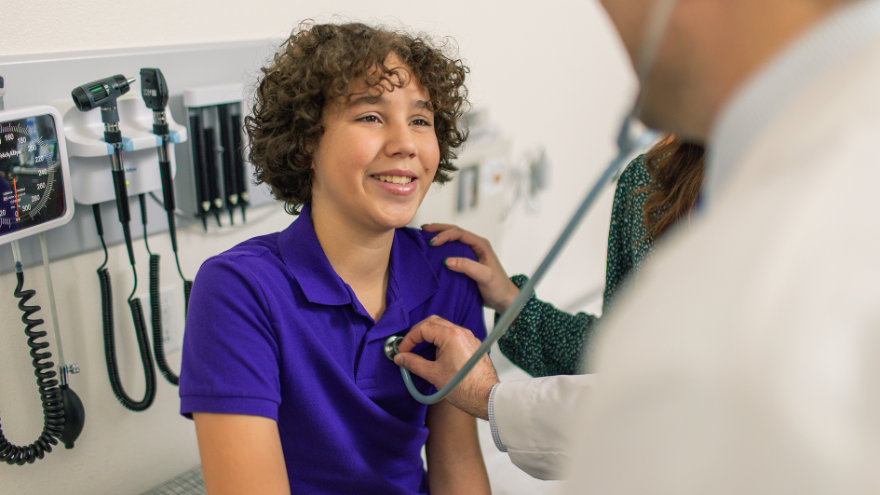Search
-
Child Fever: When To Seek Medical Care
When your child has a fever, worrying about their discomfort and illness is natural. However, fevers are part of the body's defense against infections, aiding your child's recovery. While rest and home remedies often help, it's important to know when to seek medical attention to keep your little ones safe and healthy. Symptoms of a Fever Fevers can be caused by infections, teething, vaccinations, hot environments, and autoimmune diseases. During a fever, your child may experience visible symptoms such as: Chills Disinterest in food Fussiness Headache Sore throat Cough/Congestion Feeling warm to touch Vomiting/Diarrhea Providing Comfort to Your Child Use these recommendations to make your child feel more comfortable as they recover. Use lightweight clothing and blankets to help regulate their body temperature. Encourage hydration by providing clear fluids and offer soft, easy-to-digest foods. Sponge bath with lukewarm water (do not use cold water as it can worsen symptoms.) Offer restful and quiet activities. Check with your child’s pediatrician to see if you can give them acetaminophen or ibuprofen. Continue to monitor symptoms and temperature. When to Seek Medical Attention Trust your instincts and always lean on the side of caution. In certain situations, a fever may need medical attention and treatment.
-
Managing Anxiety Around School Violence
Reviewed by Dr. Takesha Cooper, MD, MS, FAPA, Chair, Department of Psychiatry and Behavioral Sciences, Professor of Psychiatry at University of Nevada Reno School of Medicine, Chief of Behavioral Health at Renown Health Sometimes it feels like every time you turn on the news, there is a new report about violence in our schools. Instead of being able to focus on the typical youth growing pains of learning test-taking skills, dealing with physical body changes, navigating friendships and dating and figuring out grades and routines, our children instead must prepare to deal with active shooter incidents, bullying, gang presence and hate crimes. These are heavy weights for children to bear and simply preparing for the possibility of such events can affect their mental health. As adults, it’s important to recognize when our children are struggling with anxiety, and to equip them with healthy tools and resources to help manage it. How to recognize signs of anxiety in children Anxiety in children can present itself in several different ways, depending on the child. Oftentimes, younger children will suffer from actual physical symptoms. They may wake up with a stomachache or headache, or they may often feel tired or irritable. In pre-teens and teens, anxiety can take the form of behavioral changes. They may withdraw from social connections and activities or have trouble sleeping or eating. As a parent, it may be difficult to know what to do when you see your child struggling with anxiety over school violence. How can you help your child when you are trying to figure out the same answers for yourself? You should know, however, that one of the best things you can do for your child is to simply be there for them. Anxiety tries to convince us that we are alone in our feelings, creating a sense of isolation, guilt and shame. A hug, reassurance and open conversation can provide the comfort your child needs during times of anxiety. How to talk to children about school violence Some important things to remember when talking to your children about school violence are: 1. Present the facts: Many times, children receive information about school violence from unreputable sources. Social media, peers and even family members are not always the most accurate sources of data and facts. Take the time to confirm the main details to stop wild theories and accusations in their tracks. 2. Provide Reassurance: It’s okay to let your children know when you are sad or scared about school violence, but you should do so in an age-appropriate manner and follow up with honest parental reassurance. Keep your explanations of the violent incident short and tailored to the age of the child. Acknowledge their feelings and the current situation but be sure to remind them that there are rules, laws and people in place to protect them, should that protection ever be needed. You can empathize with their anxious thoughts and feelings but also remind them that you are there to take care of them and that it is not their responsibility as a child to worry about school violence. 3. Promote Open Communication: Don’t be afraid to have complicated conversations with your children. They are usually able to process more than adults give them credit for. Find opportunities to have one on one time with your child and guide the discussion towards their anxious thoughts and feelings. Actively listen and validate their feelings without escalating fear and remind them that you are a safe and trusted resource who will not dismiss or judge their feelings but promises to be there as a support system. 4. Prepare with the Necessary Tools: Help teach your children coping mechanisms such as deep breathing, yoga, mindfulness or journaling. They can also learn to process their thoughts through physical outlets such as exercise, sports or hobbies to help foster a sense of control and normalcy. 5. Practice Safety Routines: While it can be sad to acknowledge that bad things happen in the world, it can be empowering for children to learn that there are sometimes things they can do to help in a challenging situation. You can discuss safety measures at school and remind them of teachers, staff and first responders who are available to help. Additionally, some children find that role-playing emergency protocols can help them feel prepared and powerful. 6. Protect Their Media Intake: In today’s world, news and information are available 24/7, coming to us from numerous media platforms. For adults, this constant stream of content can feel overwhelming, and for children, it can be even more distressing—especially during times of crisis. Children may struggle to process the information they have been exposed to, and they may lack the ability to distinguish between factual reporting and sensationalism. This constant influx of bad news can take a toll on their mental health, and they may not even recognize that they’re feeling stressed. Limiting their media exposure is an important step in caring for their emotional well-being. Take Care of Yourself Each time you fly on an airplane, the flight attendants tell you to “put your oxygen mask on first before helping others.” This is important because, in order to think clearly and be helpful to others in need, you have to be able to breathe and function on your own. This adage also rings true when it comes to helping your children manage their anxiety. You must take care of yourself and manage your own fears and stress so that you can effectively provide guidance and support to your children. Remembering to eat properly, exercise, get enough sleep and find strategies to manage your own mental health are crucial to you being the best you can be, so that you can provide comfort to your child and advocate for their health and wellbeing. When to Seek Professional Help Remember that it’s okay to ask for help. If you find that you or your child are struggling with depression, anxious thoughts, persistent fears, loss of appetite, irritability, lack of desire to engage in life activities or with loved ones or other signs of distress, please reach out for professional help. Counseling, support groups and therapy with a licensed mental health professional are all effective ways to cope with these emotions and serve as a helpful reminder that no one has to face them alone. Click here for additional information about Renown Behavioral Health.
-
Importance of Well Child Visits
It’s important to establish children with a pediatrician so that their health baselines can be monitored regularly throughout each stage of their life, from infancy to young adulthood. Well-child visits are comprehensive, preventative check-ups that are vital to each child and teen’s overall health and wellbeing. At Renown Children’s Hospital, our Pediatric Primary Care team is dedicated to treating children with personalized medical care – we are focused on each child’s individualized healthcare needs, offering services ranging from well-child visits and immunizations to sports physicals, care for illnesses and minor injuries, mental health support and specialist referrals when needed. Here is an overview of the timeline and importance of well-child visits for you to reference as you care for your children. Well-Child Visit Schedule Renown Children’s Primary Care provides the following well-child visit schedule: Three to five days after birth 2 weeks Two months Four months Six months Nine months One year 15 months 18 months Two years, and yearly after
-
Protect Your Child’s Health with Timely Vaccinations
Why are timely vaccinations important? Childhood vaccinations are scheduled and vaccines are administered when young bodies require immediate protection or need to build immunity for diseases and illnesses we may encounter throughout our lives. Delaying recommended vaccinations puts children at higher risk for diseases that can affect them more harshly, like pertussis (whooping cough), which is especially dangerous for babies. Vaccination Benefits Vaccinations save the lives of 1,000s of children (and adults) every year Vaccinations protect us from illnesses that can lead to cancer, hospital stays, life-long health issues & even death Vaccinations help protect those who receive the vaccines and, through herd immunity, also help protect the unvaccinated and seniors whose immunity may have waned. What’s the recommended vaccine schedule for children? In the U.S., we follow the CDC’s vaccine schedule for children and teens up to 18 years of age. The schedule also provides notes regarding missed or late vaccine doses and how to properly “catch-up.” If your child is missing one of the vaccinations listed below, is not quite on-schedule with the recommended timeline or you have any questions regarding vaccines or timings, please reach out to your child’s provider. Vaccine Schedule Birth to 4 Years: Birth – First vaccine for hepatitis B and may receive respiratory syncytial virus (RSV)* vaccine 2, 4 & 6 months of age – Vaccines/boosters for tetanus, diphtheria and pertussis (DTaP), polio (IPV), haemophilus influenza type B (HiB), pneumonia, hepatitis B and rotavirus 6 months to 4 years of age – COVID-19 vaccine, 1-2 doses* 1 year of age – First dose of measles, mumps, rubella with varicella for chicken pox (MMRV) vaccine and boosters for hepatitis A, HiB and pneumonia 15 months of age – 4th dose of DTaP 18 months of age – 2nd dose of hepatitis A 4 years of age – Final dose of MMRV, TDaP and IPV vaccines *Conditions apply. See your child’s provider. Vaccine Schedule 5 Years & Older: CDC and American Academy of Pediatrics (AAP) also recommend the following vaccine schedule for children as they grow: Prior to starting middle school – TDaP and meningitis vaccines/boosters 9-12 years of age – AAP suggests children (and those up to 26 years of age who have not been adequately vaccinated) receive the HPV vaccine to help protect against developing certain cancers as adults Children up to 18 years of age & adults – COVID-19 vaccines are recommended, especially for those with medical conditions such as asthma and diabetes For more vaccination information, please refer to the CDC recommended child and adolescent immunization schedule. Any tips on preparing my child for a vaccination? Many parents worry about side effects like pain and fever for their children after getting vaccinations. Studies have shown that giving Tylenol prior to vaccines can decrease their effectiveness. That’s why providers recommend parents and caregivers wait until after vaccines are administered before giving Tylenol or Ibuprofen, and then only if symptoms develop. Do vaccinations wear off? Many vaccinations provide life-long immunity while others may wear off over time. Vaccines are given to children when they are at most risk for contracting diseases as well as when they are at the highest risk of severe complications from a disease. So even if immunity fades over time, it is important receive vaccinations on time to protect children during these high-risk windows. Doctor's Advice: Ensure Your Child's Health with Timely Vaccinations A child receiving a vaccination can be a scary thing for some parents and misinformation about vaccines on social media and the internet can make things confusing. It is important for parents to discuss any questions they have about vaccines with their child’s health care provider. As medical providers caring for children, we all have the common goal of keeping children the healthiest they can be – and vaccines are an important part of that. To schedule an appointment with a Renown provider, please go here and click here to learn more about Brittany Lemons, MD.
Read More About Protect Your Child’s Health with Timely Vaccinations
-
Think Outside the Box: Healthy, Creative School Lunch Hacks
Today's school lunch is an opportunity to create a healthy, colorful midday meal, far from the days of soggy PB&Js. Here are simple tips, a week of lunch ideas, and a shopping list to help you pack a lunch your child won't want to trade. Packing lunches ensures your child gets a well-balanced meal, and making it a team effort by having kids help can save time by packing the night before. Nutritious Ideas Main dishes Lunch meat and low-fat cheese roll ups English muffin pizzas Sandwich wraps – meat, cheese and veggies in a whole grain tortilla Pita pockets stuffed with grilled chicken and vegetables Soup Chef salad with spinach, veggies, cheese, lunch meat and dressing Tuna or chicken salad on a mini bagel Snacks and sides Fresh or dried fruit Natural apple sauce Baked tortilla chips and salsa Veggie sticks and hummus Cheese slices or string cheese with whole grain crackers Homemade trail mix with nuts, seeds and raisins Pudding Homemade fruit roll ups Popcorn (add different toppings such as salt, garlic, cinnamon, sugar or cayenne pepper) Drinks Water If you child doesn’t like plain water, try adding a few slices of fresh fruit (strawberries, lime, lemon) for more flavor. School Lunch Menu: Day-By-Day We’ve put together a week’s worth of colorful, fun and healthy school lunch ideas your kids will love. And we’ve also created a shopping list to help you easily locate all the ingredients on your weekend shopping trip. Monday: Turkey BLTA Roll-ups Roll-up Ingredients Turkey, cold cuts Bacon Avocado Tomatoes Side Dish Choices Blueberries Cucumbers Carrot sticks Tuesday: Bacon & Cucumber Sandwich Sandwich Ingredients Whole wheat English muffin Cucumber Bacon Side Dish Choices Apples slices Strawberries Vanilla yogurt mixed with sprinkled cinnamon Wednesday: DIY Lunchables Lunchables Ingredients Crackers Turkey, cold cuts Cheese Side Dish Choices Blueberries Carrots Cucumber Thursday: Veggie Grilled Cheese Veggie Grilled Cheese Ingredients English muffin Cheese Tomato Spinach leaves Avocado Side Dish Choices Apples slices Strawberries Vanilla yogurt mixed with sprinkled cinnamon Tomatoes Friday: DIY Pizzas DIY Pizza Ingredients 2 toasted English muffins Pizza sauce Cheese Turkey pepperoni Side Dish Choices Celery Black olives Shopping List (under 20 items) Cold section: Dairy 1 large container of vanilla yogurt 1 package of your favorite cheese Cold section: Deli meats 1 package of turkey pepperoni 1 package bacon 1 package turkey cold cuts Inside aisles Whole wheat English muffins 1 can of whole black olives 1 jar of pizza sauce 1 box of whole wheat or multigrain crackers Produce department 1 cucumber 1 stalk of celery 2 apples 1 container of strawberries 1 avocado 2 tomatoes 1 bunch of spinach leaves 1 container of blueberries 2 carrots
Read More About Think Outside the Box: Healthy, Creative School Lunch Hacks
-
How the HPV Vaccine Protects Your Health
As the back-to-school season approaches, ensuring your child is ready for a successful academic year goes beyond school supplies and new clothes. It's also the perfect time to prioritize their health by ensuring they're up-to-date on essential vaccinations, including the HPV vaccine. We talked to Renown Pediatrician Dr. Kristin Wilson, to learn more about HPV and the importance of getting your child fully vaccinated. What is HPV? Human papillomavirus (HPV) is a common sexually transmitted disease. It can lead to the risk of several cancer diagnoses, with about 13 million Americans, including teens, becoming infected each year. Fortunately, a vaccine can prevent more than 90% of HPV cancers when given at the recommended ages. Talking about sexually transmitted infections can be uncomfortable, but learning how HPV is spread is important for prevention. Here's what you need to know about HPV: Transmission: HPV is spread via skin-to-skin contact. Types of HPV: Low/Medium-risk HPVs: Can cause warts and cervical dysplasia (abnormal cells on the cervix). High-risk HPVs: Can cause various cancers. HPV-related Cancers: Cervical cancer Anal cancer Vaginal cancer Vulvar cancer Penile cancer Oropharyngeal (mouth and throat) cancer Statistics: Men are four times more likely than women to suffer from HPV-associated oropharyngeal cancer. HPV is so common that nearly all sexually active people will be exposed at some point in their lifetime. Around half of HPV infections are of the high-risk variety.
-
Childproof Your Windows - 8 Tips to Avoid Falls and Ensure Safety
Enjoying the fresh air through an open window is one of the many ways to enjoy the weather. However, open windows can pose safety risks, including injury or fatalities for young children aged two to five. We spoke with Jorge Montano-Figueroa, Pediatric Injury Prevention Specialist at Renown Children’s Hospital to understand how window falls can be prevented through safety devices and practicing careful habits. Use these tips to keep your children safe from window falls. Supervise Young Children: Always keep an eye on young children, especially when they are near windows. Supervision is the first line of defense against accidents. Keep Windows Closed and Locked: When possible, keep windows shut and secure. Locked windows prevent children from opening them and potentially falling out. Open Windows from the Top: If your windows allow, open them from the top down rather than the bottom up. This reduces the chance of children reaching the opening. Ensure that the opening is limited to four inches or less to prevent accidental falls. Install Child Safety Devices: For windows six feet or more above the ground, child safety devices such as window stops or guards are a must. These devices are readily available at hardware stores and for purchase online. They are designed to be easy for an adult to release in an emergency but secure enough to prevent a child from opening the window too wide. • Window Stops: These devices prevent windows from opening more than four inches, significantly reducing the risk of falls. • Window Guards: For windows that need to open more than four inches, window guards provide a barrier to prevent falls while allowing ventilation. Keep Climbing Hazards Away: Move furniture and other items that children could use to climb away from windows. Items such as chairs, beds, and couches can be stepping-stones for curious children. Establish a Safety Zone: Make it a household rule that children should play at least two feet away from windows. This safety zone helps keep them keep potential hazards out of reach. Childproof When Visiting: When visiting homes that may not be childproof, take extra precautions. Close and lock windows during your visit and watch your child closely to ensure they stay safe. Remember: Window Screens Are Not Safety Devices: Window screens are designed to keep bugs out, not children in. Screens can easily pop out if a child leans or pushes against them, leading to falls. Always use proper child safety devices instead of relying on window screens. By taking these precautions, you can significantly reduce the risk of window falls and keep your children safe. A few simple steps and some vigilance can make a big difference in preventing these potentially tragic accidents. For more information and to learn more, visit Pediatric Injury Prevention.
Read More About Childproof Your Windows - 8 Tips to Avoid Falls and Ensure Safety
-
How to Protect Your Kids from Heatstroke
With the dangerous heat wave impacting our region, there are heightened risks of heatstroke, especially for children who cannot regulate their body temperature as efficiently as adults. Infants are particularly vulnerable and may not express discomfort, so never leave a child unattended in a vehicle. Top Tips for Preventing Heatstroke Reduce the number of deaths from heatstroke by remembering to ACT. Avoid heatstroke-related injury and death by never leaving a child alone in a car, not even for a minute. And make sure to keep your car locked when you’re not inside so kids don’t get in on their own. Create reminders. Keep a stuffed animal or other memento in your child’s car seat when it’s empty, and move it to the front seat as a visual reminder when your child is in the back seat. Or place and secure your phone, briefcase or purse in the backseat when traveling with your child. Take action. If you see a child alone in a car, call 911. Emergency personnel want you to call. They are trained to respond to these situations Keeping Your Baby Cool in the Back Seat In hot weather, it is crucial to keep your baby cool and hydrated by using a car seat cover or towel over them to reflect the sun's rays. Dress your baby in lightweight clothing that covers their arms and legs. Keep an eye on your baby's skin color. Move them to a cooler place if they look too red or flushed. Keep the temperature at a comfortable temperature for you, not for your child. Keep the windows cracked open for ventilation and ensure nothing is blocking the airflow from entering or exiting the vehicle. Dress your infant appropriately for their environment, including appropriate head and neck coverings, to keep them cool and protected from sunburns. Ensure you have enough fluids to last an hour before getting out of the car or use bottled water if possible. Never leave your child unattended in a car. Steps to Follow if You Suspect Heatstroke Call 911 immediately. Cool the victim – Get the person to a shady area, remove restrictive clothing and cover skin with sheets soaked in ice-water, and place ice packs in the arm pits and groin. Have the victim drink cool fluids, preferably an electrolyte-containing sports drink. Monitor body temperature with a thermometer but stop cooling efforts after temperature has dropped to 102 Fahrenheit. Baby Safe Classes These classes help prepare parents for emergencies that may occur in baby’s first year. Safe Kids Worldwide Did you know heatstroke is the leading cause of non-crash related fatalities in children? “On average, every 10 days a child dies from heatstroke in a vehicle. In more than half of these deaths, the caregiver forgot the child was in the car.”
-
Why Childhood Immunizations Are So Important
Immunizations save thousands of lives each year by preventing serious illnesses, hospitalizations, and deaths. They also protect those who can't be vaccinated, like young children and the elderly, through herd immunity. Renown Pediatrician Dr. Kristin Wilson highlights the crucial role of vaccines. Immunizations Your Child Needs (and when) Birth to 6 Months Hepatitis B: Shortly after birth, first vaccine dose Diphtheria, Tetanus, and Pertussis (DTaP), Polio, Haemophilus Influenza (HiB), Pneumonia, Hepatitis B and Rotavirus: Ages 2, 4 and 6 months, boosters and vaccines One Year to 18 Months MMR and Varicella (chickenpox) vaccine: Age 1, first vaccine dose Hepatitis A, HiB and Pneumonia: Age 1, booster DTaP: 15 months, fourth vaccine dose Hepatitis, second dose: 18 months Flu Vaccine: 6 months and older, annually* *In the year after receiving their first dose, an infant will need a booster one month later. Four Years Old MMRV, DTaP and Polio, final dose: Four years of age Pre-Teen and Beyond Tdap and Meningitis: Before starting middle school, children receive these vaccines. They are also old enough to start the HPV vaccine, an essential vaccine for all young adults to protect against cancer, genital warts and cervical dysplasia.
Read More About Why Childhood Immunizations Are So Important
-
Pediatric Sepsis: Causes, Symptoms and Treatment
Sepsis happens when a person's body reacts too strongly to an infection. Usually, our bodies fight infections with help from our immune system. But with sepsis, the body fights too hard, and that can be dangerous. Dr. Julianne Wilke, Pediatrics and Critical Care Medicine, examines pediatric sepsis's causes, symptoms and treatments and provides tips on preventing this potentially fatal condition. Most Common Causes Pediatric sepsis is a particularly concerning form of sepsis that can occur in children and infants. Therefore, it is vital for parents and caregivers to be aware of the indications of pediatric sepsis and to understand the causes. Bacterial infections are the most common cause of pediatric sepsis, accounting for over 80% of cases. Common Bacterial Causes: Staphylococcus infections (including Methicillin Resistant Staphylococcus Aureas - MRSA) Streptococcal infections (including those causing pneumonia and group B strep) Escherichia coli, or more commonly; E. coli Klebsiella and Pseudomonas infections Viral Infection Causes: Respiratory syncytial virus (RSV) Influenza Parainfluenza Adenovirus Human metapneumovirus Coronaviruses (including COVID-19) Other Causes: Fungal infections (but are relatively rare) Parasites, such as Giardia lamblia Pediatric Sepsis Symptoms Parents and caregivers need to be observant of sepsis symptoms in children and can include: Fever Extremely fast heart rate Rapid breathing Lethargy Pale or discolored skin Low blood pressure Confusion Slurred speech Abdominal pain Diarrhea & Vomiting Decreased urination Difficulty breathing Use the acronym SEPSIS: S – Slurred speech and confusion E – Extreme shivering or muscle pain/fever P – Passing no urine all day S – Severe breathlessness I – “I feel like I might die.” S – Skin mottled or discolored If any of these symptoms are present, seeking immediate medical attention is imperative.
Read More About Pediatric Sepsis: Causes, Symptoms and Treatment
-
What You Need to Know About RSV
Respiratory syncytial virus, also known as RSV, is a common respiratory virus that impacts the lungs and breathing pathways. The virus can be dangerous for infants and young children and is also concerning for older adults. While most older kids and adults only experience cold-like systems and recover in a week or two, an estimated 58,000-80,000 children younger than 5 years old are hospitalized due to RSV each year, and in 2022 healthcare organizations across the country are experiencing higher infection rates than in years past. "We are experiencing a strong RSV season and do not expect it to go away anytime soon," said Dr. Kris Wilson, Division Chief of Renown Children's Primary Care. "Infants who are infected with RSV almost always show symptoms of runny noses and cough. Call your healthcare provider immediately if your child is having difficulty breathing, is not drinking enough fluids, or is experiencing any worsening of these symptoms.” Symptoms of RSV: Runny nose Decrease in appetite/inability to drink Dry diapers, an indication of dehydration Cough, which may progress to wheezing or difficulty breathing Irritability (most common in very young infants) Decreased activity (most common in very young infants) Decreased appetite (most common in very young infants) Apnea, pauses in breathing for more than 10 seconds (most common in very young infants) What to do if you think your child has RSV: Call your pediatrician! If you suspect your child might have RSV, consulting their healthcare provider is the best first line of defense. From here they will help you build an appropriate treatment plan for child. Keep in mind that many pediatrician offices offer 24/7 call lines. If your child is experiencing retracted breathing (when the area between the ribs and in the neck sinks in when a person attempts to inhale), dehydration (not drinking and decrease in wet diapers) or apnea (pauses in breathing for more than 10 seconds) please call 911 or go to the closest emergency room.
-
Department Spotlight: Children’s Infusion Services
Help us celebrate the holiday season by sharing joy with our Children’s Infusion Services team! Thinking about blood can make any of us squeamish, and seeing it can be even more intimidating to the children in our lives. Being treated for a condition that requires blood transfusions or chemotherapy infusions is no easy feat, especially during the holiday season. This time of year, we are proud that we can offer our pediatric patients the power of proximity and excellence by having access to high level care close to home. The Children’s Infusion Services (CIS) department at Renown Children’s Hospital is committed to bringing the gift of quality care to our community’s youngest patients. Whether they are caring for a child with a blood disorder or giving expert infusion care for a child battling cancer, no team does what they do better than these expert nurses, medical assistants, intake coordinators and physicians. ‘Tis the Season to Bring Hope As the only pediatric oncology and hematology program in the region, the CIS department has a lot of responsibility on their shoulders. From inpatient chemotherapy to outpatient infusion services, this team treats a long list of pediatric blood conditions including: Pediatric cancers Anemias Immune-mediated blood disorders Sickle-cell disease Bone marrow failure syndromes Bleeding disorders “Our team provides a large variety of services from labs draws, sedations for procedures, infusions for diagnoses such as Crohn's disease, blood transfusions, as well as chemotherapy,” said Jen Torres, RN. “Our team works extremely well together. We try to go above and beyond for our patients every day. It may be something as simple as a hug to comfort a parent or a special birthday gift for a patient.” “My job allows me to work with several departments and providers when coordinating care for our littlest of patients,” added Jane Strawn, Intake Coordinator. “I assure proper authorizations are in place for the care that is needed, I communicate with our families when scheduling appointments, I organize End of Treatment Celebrations, as well as birthday shout outs and work closely with our Child Life team to help make the challenging appointment little easier.” To best serve their patients, the team thrives on being expert multitaskers. Central line care, chemotherapy administration, blood transfusions, medication management, preventative injections, lab draws, lumbar punctures, biopsies, imaging – you name it, they do it. And they do it all with the utmost focus on safety and support. “Our days have a lot of variation, as we perform a number of different services,” said Meagan Bertotti, RN. “We provide infusions for patients with chronic or acute medical conditions and chemotherapy/biotherapy treatment to patients undergoing cancer treatments. Overall, though, we work as a team to make these difficult procedures and treatments as easy as possible for the patients and families by providing engagement and support.” “While we handle a lot of chemotherapy treatments for pediatric patients, we also do other infusions and transfusions as well such as blood and platelet transfusions, enzyme replacement therapies, different types of injections such as Rabies vaccine or Synagis for high-risk babies who need that extra protection during the RSV season, and lab draws,” said Chelsea Angues, RN. “We care for patients that get their therapies from outside hospitals, but the patient lives within the Reno area. We receive orders from those outside hospitals to care for those patients, so they can still be with their families and not have to travel.” As members of the Children’s Oncology Group, a highly-regarded clinical trials group where over 90% of pediatric cancer patients across the U.S. receive treatment, teams like CIS in Renown Children’s Hospital deliver the highest standard of care. This partnership is a true testament to the devoted collaboration and relationship-building this team commits to on behalf of their patients every day. "One of the biggest accomplishments of our team is the fact that we became a member of the Children’s Oncology Group, and the Children's Infusion Center and Pediatric Oncology became one unit,” said Shelby Nolte. "Instead of being a clinic on one side and an infusion center on the other, we really came together to make it a whole unit that collaborates on almost everything.” “We've put much time into trying to understand other departments, their flow, their rationales and their processes so we can come to a solution that benefits our patients the greatest,” added Tiffany Macie, RN. “We've taken the last few years to really build our relationships with our pharmacy staff, our lab staff and our central supply resources. Our relationship building extends beyond the walls of the Renown building as well and out to the community providers too. In the past few years, we've been able to build relationships with the providers in the community where they trust they can send us their patients for treatment and lab draws. Finally, we've spent much time working on the relationships as a team. It's emotional work we do on our unit, and these families become our family. It's important to us that we take the time to be together outside of our shifts to enjoy one another and laugh!” In the compassionate realm of pediatric healthcare, CIS knows that the complexities of a cancer or blood disorder diagnosis can take an emotional toll on their patients and families. The team firmly believes that emotional support can be as important as the physical and medical support throughout each patient’s unique care journey, striving to be a comforting presence during daunting times. “The most important part of my day is collaborating with the Children's Infusion team to make life manageable for the families that are going through this experience,” added Shelby Nolte, Senior Medical Assistant. “We work as a team to make life easier for the blow of a cancer diagnosis. We are there for our families in every way. If they need a shoulder to cry on, an ear to listen or just someone to play cards with or tell a funny story too, we are there.” “One of the things our team does extremely well to help our patients and their families with new diagnoses is to simply meet them where they are,” said Tiffany Macie. “That looks different for every family and every patient. We work in an environment where can build relationships with our patients and their families. This allows us the unique opportunity to really get to know them. We learn their fears, their joys, their worries, what their family lives are like, and we learn how to best meet them where they are.” Transcending the conventional boundaries of care, the CIS department closely supports each patient, offering them solace tailored to the unique fabric of each family's life.
Read More About Department Spotlight: Children’s Infusion Services











